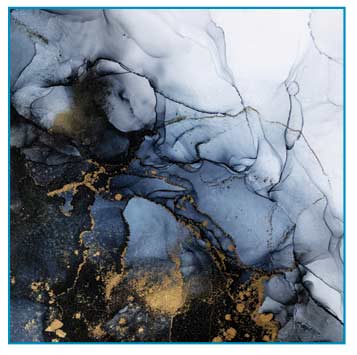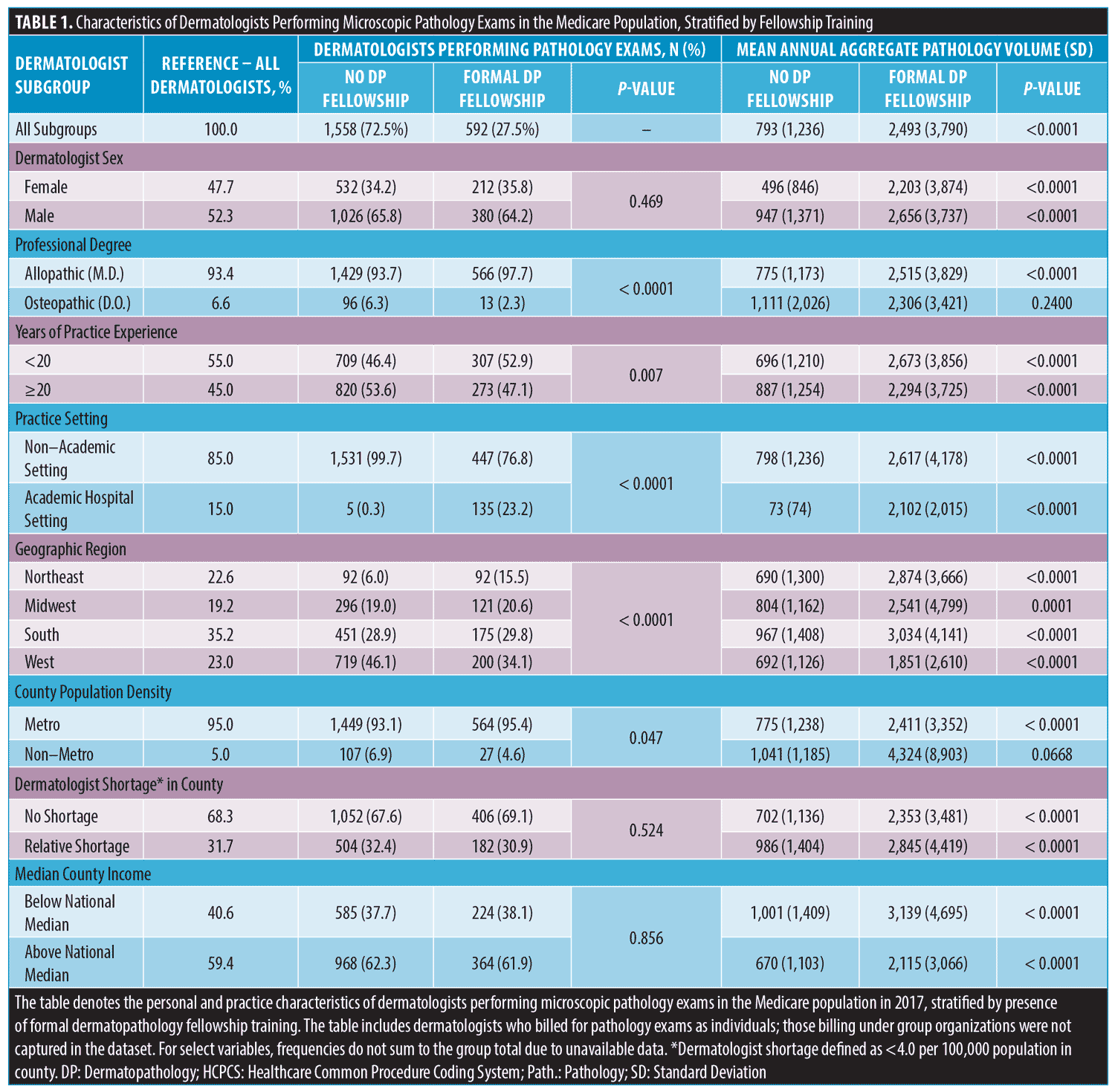 J Clin Aesthet Dermatol. 2022;15(8):38–40.
J Clin Aesthet Dermatol. 2022;15(8):38–40.
by Christian Gronbeck, MD; Philip E. Kerr, MD; Hao Feng, MD, MHS
All authors are with the Department of Dermatology at the University of Connecticut Health Center in Farmington, Connecticut.
FUNDING: No funding was provided for this article.
DISCLOSURES: The authors report no conflicts of interest relevant to the content of this article.
ABSTRACT: Objective. Dermatopathology training is incorporated into dermatology residency programs, yet some individuals choose to pursue additional fellowship training in dermatopathology. We sought to characterize the impact of dermatopathology training on practice patterns of dermatologists performing pathology exams in the Medicare population.
Methods. We conducted a cross-sectional review of the 2017 Medicare Public Use File to identify all residency-trained dermatologists performing microscopic pathology exams in 2017. Formal dermatopathology fellowship training was identified through the American Board of Medical Specialties website.
Results. There were 2,150 dermatologists performing pathology examinations in 2017; of these, 592 (27.5%) had formal dermatopathology fellowship training. Fellowship training was associated with a higher mean annual pathology exam volume. Those without fellowship training were more likely to practice in the West, in non-academic settings, and in non-metropolitan counties.
Limitations. Residency-trained pathologists are not included in the sample. Additionally, some dermatopathology labs may submit claims as an entire organization, rather than at the level of each physician.
Conclusion. Fellowship-trained dermatopathologists perform pathology exams at a higher rate than their non-fellowship-trained colleagues and are concentrated in academic practice settings. The findings support the important role of fellowship-trained dermatopathologists in evaluating a wide array of skin pathologies.
Keywords: Dermatology, dermatopathology, pathology, fellowship, residency, graduate medical education, Medicare
Although dermatopathology is taught during dermatology residency and this training is utilized by some dermatologists to interpret their own pathology specimens in practice,1 other dermatologists pursue advanced training through a dermatopathology fellowship. We sought to identify the impact of dermatopathology training on the practice patterns of dermatologists performing pathology exams, which has not been previously examined at the national level.
Methods
We conducted a cross-sectional review of the 2017 Medicare Public Use File to identify all residency-trained dermatologists performing microscopic pathology exams in 2017.2 Dermatologists with greater than 10 microscopic pathology exams (Current Procedural Terminology codes 88304, 88305, 88307, or 88309) in 2017 were included in the analysis. For each dermatologist, formal dermatopathology fellowship training was determined through the American Board of Medical Specialties and professional websites.3 Dermatologist characteristics, practice patterns, and mean annual pathology exam volume were assessed. Each clinician’s billing address was used to identify geographic county, which was correlated with American Community Survey data to determine rurality and income. For all billed pathology exams, the published allowed Medicare payment amount was verified against that in the database to evaluate for potential errors, leading to the removal of eight entries.
Results
Among 2,150 dermatologists performing pathology exams, we identified 592 (27.5%) with dermatopathology fellowship training. Compared to those with fellowship training, those without were more likely to have at least 20 or more years of dermatology experience (53.6% vs. 47.1%, p<0.0001) and practice in the West (46.1% vs. 34.1%, p<0.0001), in non-academic settings (99.7% vs 76.8%, p=0.007), and in non-metro counties (6.9% vs. 4.6%, p=0.047). Fellowship training was associated with a significantly higher mean annual pathology exam volume (2,493 vs. 793, p<0.0001) (Table 1).

Discussion
The findings demonstrate that a significant number of non-fellowship-trained dermatologists interpret skin pathology specimens in clinical practice, although at lower volumes than their fellowship-trained peers. While the clinical context of this practice is unclear, it may indicate the comprehensiveness of dermatopathology training in dermatology residencies, many of which contain specific dermatopathology rotations.1 Survey data suggest that dermatology residency programs in the Southern United States may have a greater overall volume of dermatopathology training.1 Given that many dermatologists practice near their residency training site,4 this could partially explain the relatively greater mean volume of pathology exams in this region.
Fellowship-trained dermatopathologists have additional formal training and high accuracy in identifying complex non-melanocytic and melanocytic neoplasms.5 The substantially greater pathology exam volume among these individuals, likely through higher referrals, may reflect this extensive experience and demonstrate their important role in evaluating a wide array of skin pathologies.
Non-fellowship-trained dermatologists who submitted pathology claims were more frequently located in the West compared to the Northeast. The explanation for this is unclear but might be related to the relatively high concentration of dermatopathology fellowship programs in the Northeast (~36%) compared to other regions. Presence of fellowship training did not differ by dermatologist density or county income. However, mean pathology exam volumes were overall higher in rural, low-income counties and in those with dermatologist shortages, potentially signaling a need for dermatopathology services in these areas.
This study was unable to identify all physicians performing pathology exams, as residency-trained pathologists are not included in the dermatology sample and because some dermatopathology labs submit claims as an entire organization (see additional Table footnotes). However, the identified sample of fellowship-trained dermatopathologists is representative of the broader dermatopathology workforce in terms of practice setting and gender.6 Additionally, these pathology statistics represent Medicare-associated specimens only, and total volumes are likely higher for many individuals. Despite these shortcomings, the study provides greater characterization of dermatologists performing pathology exams at a national level stratified by fellowship training.
References
- Hinshaw M, Hsu P, Lee LY, et al. The current state of dermatopathology education: a survey of the Association of Professors of Dermatology. J Cutan Pathol. Jun 2009;36(6):620–628.
- Centers for Medicare and Medicaid Services. Medicare Physician & Other Practitioners – by Provider and Service. https://data.cms.gov/provider-summary-by-type-of-service/medicare-physician-other-practitioners/medicare-physician-other-practitioners-by-provider-and-service/data/2017.
- Certification Matters. Is My Doctor Board Certified? Accessed October 4, 2021. https://www.certificationmatters.org/find-my-doctor/
- Resneck JS, Jr., Kostecki J. An analysis of dermatologist migration patterns after residency training. Arch Dermatol. Sep 2011;147(9):1065–1070.
- Gaudi S, Zarandona JM, Raab SS, et al. Discrepancies in dermatopathology diagnoses: the role of second review policies and dermatopathology fellowship training. J Am Acad Dermatol. Jan 2013;68(1):119–128.
- Suwattee P, Cham PM, Abdollahi M, et al. Dermatopathology workforce in the United States: a survey. J Am Acad Dermatol. Dec 2011;65(6):1180–1185.

